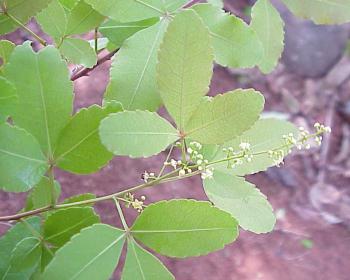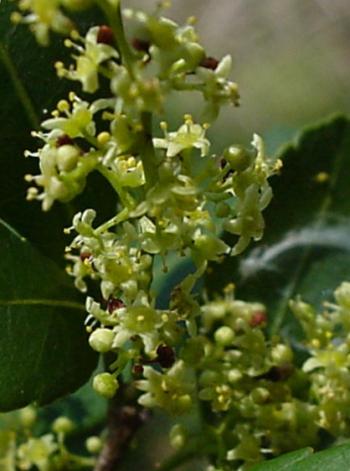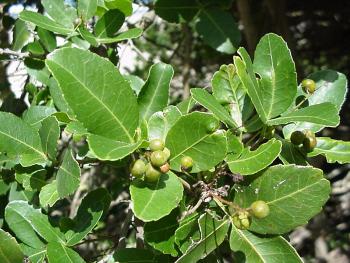Searsia natalensis
Searsia natalensis (Bernh.ex C.Krauss) F.A.Barkley
Family: Anacardiaceae
Common names: dune karee, Natal karee, northern dune currant, northern dune currant-rhus (Eng.); duinekaree, natalkaree, noordelike duinekaree (Afr.); umgwele, ingwele, ugana (isiXhosa); inhlokoshiyane (isiZulu)
SA Tree No: 390
Introduction
An attractive hedge or garden tree that is also used medicinally for various ailments. It can be easily propagated from seed.

Description
Description
Searsia natalensis is a scrambling, evergreen shrub or a small tree, up to 5 m tall. Its stem is rough, grey-brown, with resin dots (granular). The branchlets are smooth. The leaves are tri-foliate, with terminal leaflet, 20–80 × 10–30 mm, side leaflets slightly smaller, dark olive-green above, rather, light green below; midrib prominent above and below; margin slightly wavy, entire or faintly toothed in upper two thirds, broadly tapering to round tip; the stalk up to 30 mm long. The young leaves are shiny red. The leaves smell of apples when crushed.

The flowers in loosely and sparsely branched sprays, up to 70 mm long, small and greenish yellow. Searsia natalensis flowers in in spring and summer from August to March. The fruit is flattened, round in outline, up to 7 mm in diameter, smooth, shiny and reddish brown when ripe. The fruits appear in late summer to winter, from February to July.

Conservation Status
Status
According to the Red List of South African Plants, Searsia natalensis is assessed as Least Concern (LC).
Distribution and habitat
Distribution description
Searsia natalensis occurs naturally in coastal scrub and dune forests of KwaZulu-Natal and the Eastern Cape. It is also found in Mozambique, East Africa and the Comores.
Derivation of name and historical aspects
History
The genus Searsia was named after Paul B. Sears (1891–1990), who was head of the Yale School of Botany. The specific name natalensis, refers to the KwaZulu-Natal Province, where it was first collected.
It is sometimes confused with Searsia gueinzii, the dune karee, but can be separated by its scrambling habit and larger, rounded fruits. Its leaves smell of apples when crushed. Searsia natalensis can also be confused with Allophylus natalensis, which has leaves that are more spreading, no resin passages and no resinous green-apple smell.
Ecology
Ecology
The fruits are eaten, and dispersed, by birds.

Uses
Use
The plant parts, such as leaves and roots, are used medicinally for various ailments in East Africa. The pounded leaves are placed into hot water and the extract is given to the patient to drink as cough mixture. The steam from the hot leaf extract can also be inhaled to cure colds. The leaves can also be chewed to cure anthrax. The decoction of boiled leaves is used as a remedy for stomach-ache and abdominal pains. The root decoction is drunk to treat various ailments, such as venereal diseases (e.g. gonorrhoea), asthma, heartburn, abdominal pains, colds, coughs and diarrhoea. Searsia natalensis is also used for firewood, charcoal and timber. Fruits are edible. The young stems are also used as toothbrushes.
Growing Searsia natalensis
Grow
Searsia natalensis can be propagated by seed. The seeds need no treatment and retain viability for only a short period (3 months) at room temperature. The seed germination is fast. This is a fast grower and drought resistant. It makes an attractive garden hedge. It requires pruning to shape into a tree and to keep tidy.
References
- Boon, R. 2010. Pooley's trees of eastern South Africa, a complete guide. Flora & Fauna Publications Trust, Durban.
- Coates Palgrave, K. 2002. Trees of southern Africa. Struik, Cape Town.
- Jeruto,P., Lukhoba, C., Ouma, G., Otieno, D. & Mutai, C. 2008. An ethnobotanical study of medicinal plants used by the Nandi people in Kenya. Journal of Ethnopharmacology 116: 370–376.
- Kokwaro, J.O. 1976. Medicinal plants of East Africa. East African Literature Bureau, General Printers Ltd., Nairobi, Kenya.
- Mbuya et al 1994. Useful trees and shrubs for Tanzania: identification, propagation and management for agricultural and pastoral communities. Regional Soil Conservation Unit, Swedish International Development Authority.
- Neuwinger, H.D. 2000. African traditional medicine: a dictionary of plant use and applications. MedPharm, Scientific Publishers, Stuttgart.
- Pooley, E. 1993. The complete field guide to trees of Natal, Zululand and Transkei. Natal Flora Publication Trust, Durban.
- Van Wyk, Braam, A.E & Van Wyk, P. 2013. Field guide to trees of southern Africa. Struik, Cape Town.
Credits
M.S. Mothogoane
National Herbarium, Pretoria
August 2016
Plant Attributes:
Plant Type: Scrambler, Shrub, Tree
SA Distribution: Eastern Cape, KwaZulu-Natal
Soil type: Sandy, Loam
Flowering season: Spring, Early Summer
PH: Neutral
Flower colour: Green, Yellow
Aspect: Full Sun
Gardening skill: Easy
Special Features:
Horticultural zones








Rate this article
Article well written and informative
Rate this plant
Is this an interesting plant?
Login to add your Comment
Back to topNot registered yet? Click here to register.